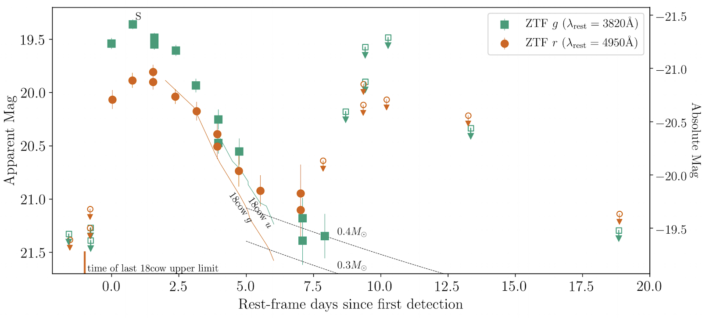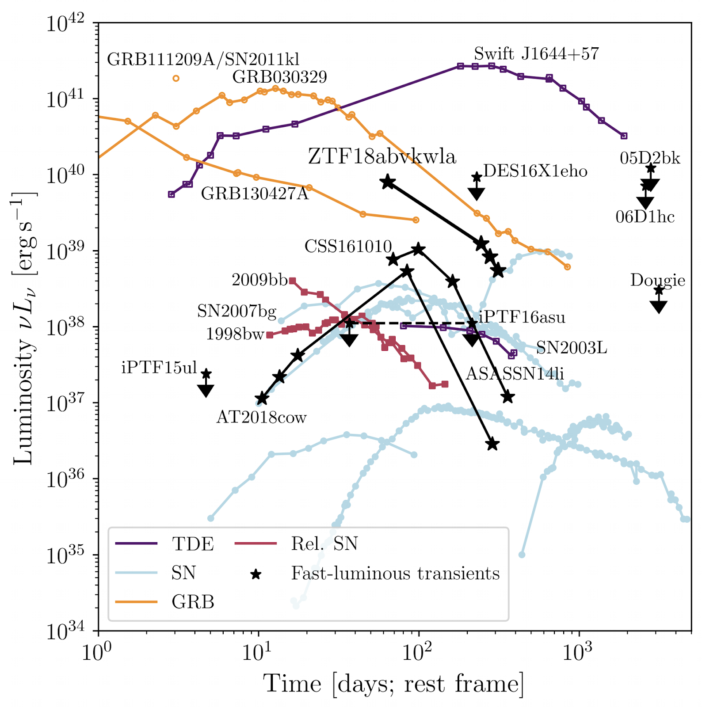Editor’s note: Astrobites is a graduate-student-run organization that digests astrophysical literature for undergraduate students. As part of the partnership between the AAS and astrobites, we occasionally repost astrobites content here at AAS Nova. We hope you enjoy this post from astrobites; the original can be viewed at astrobites.org.
Title: The Koala: A Fast Blue Optical Transient with Luminous Radio Emission from a Starburst Dwarf Galaxy at z = 0.27
Authors: Anna Y. Q. Ho et al.
First Author’s Institution: California Institute of Technology
Status: Accepted to ApJ
Furry Animals and Relativistic Transients
Astrophysicists love clever titles, and in transient astronomy, we can get some fun ones! Transient sky surveys discover thousands of new explosions every year, with each one receiving a name based on when it was discovered. For example, in 2018, a peculiar transient called Astronomical Transient (AT) 2018cow was discovered and aptly deemed “the Cow” after the last letters of its International Astronomical Union (IAU) name. Coincidently, the Cow happened to be so unique that it received worldwide acclaim as one of the most exciting discoveries of 2018!
Following its discovery, the Cow became the prototypical transient in a new class of explosions called Fast Blue Optical Transients (FBOTs), whose name is reflective of their unique observational signatures. After detection, FBOTs rise to peak brightness in only a few days (i.e. fast!) and have extremely hot temperatures, which makes them appear bluer in color than typical supernova explosions. However, astrophysicists are still puzzled at how objects like the Cow are formed: a black hole shreds a white dwarf? Or maybe a massive star implodes to form an accreting black hole or magnetar? Either way, FBOTs present a fresh mystery that can only be solved by finding and studying similar events!
Innocuous Bear or Violent Explosion?
The authors of today’s paper present the discovery of a fuzzy new FBOT, ZTF18abvkwla, which was nicknamed the “Koala” after the last four letters of its official transient name. Furry animals keep making their way into astrophysics! Unlike Earth-based koalas, this transient creature is anything but docile: observations spanning the electromagnetic spectrum revealed that the Koala was a luminous event whose turbulent explosion resulted in high temperatures and rapid ejection of stellar material. The Koala was first observed by the Zwicky Transient Factory and is located in a distant dwarf galaxy with a high star formation rate of 7 solar masses per year. The large number of new stars in the Koala’s host galaxy may indicate that this FBOT came from the explosion of a young massive star rather than from an older star system containing a white dwarf.

Figure 1: Optical light curve of the Koala (points) and prototypical FBOT, the “Cow” (lines). The remarkable evolution of the Koala shows that it rose and fell in luminosity in only 5 days, but it had an energy output similar to a normal supernova explosion! [Ho et al. 2020]
To produce both a luminous and rapidly evolving light curve like the Koala’s, the author’s discuss the possibility that the explosion was powered by the collision of outflowing material with gas in the local environment. However, this gas must also be quite opaque to radiation since the spectrum (Fig. 2) does not show hydrogen or helium emission lines that typically occur from an explosion interacting with material surrounding the progenitor star. Contrary to the comfortable climates of Australia’s native bear, the Koala’s spectrum revealed that it was an incredibly hot explosion that reached temperatures > 40,000 Kelvin!

Figure 2: Optical spectrum of the Koala with host galaxy emission lines marked in black. The spectrum indicates that the Koala had a temperature >40,000 Kelvin. [Ho et al. 2020]

Figure 3: Radio luminosities of different transients: FBOTs (black), gamma ray bursts (orange), relativistic/normal supernovae (red/blue) and tidal disruption events (purple). Another study on new FBOT CSS161010 was published soon after today’s paper. The Koala’s high radio luminosity suggests an accelerated outflow of material from a central compact object. [Ho et al. 2020]
About the author, Wynn Jacobson-Galan:
Hi there! My name is Wynn (he, him, his) and I am an NSF Graduate Research Fellow at Northwestern University where I work with Prof. Raffaella Margutti on supernova progenitor systems and transient astronomy. I am fascinated by the final moments of stellar evolution before a star dies and becomes the violent supernova explosions we observe across the universe everyday. Consequently, as a researcher, I am both a stellar physician and a mortician: I use observational astronomy to wind back the cosmic clock in order to understand how certain stars were “living” right before their explosive “death.” Outside of research, I enjoy reading (specifically 20th century literature) and skateboarding. Also, if I’m not playing music (trumpet & saxophone), I am usually trying to find fun live music in Chicago.
